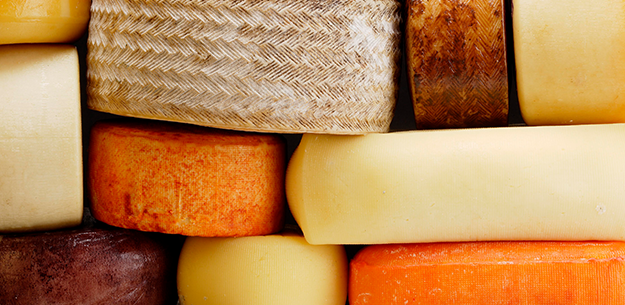.png.transform/rendition-xs/image_image%20(1).png)
Cheese
Spain’s extraordinary variety of artisan cheeses reflects centuries of tradition, diverse landscapes and skilled makers crafting distinctive flavours from cow’s, ewe’s and goat’s milk across the country.
Across Spain’s rolling plains, rugged mountains and sunlit coasts, cheese is more than food — it is heritage. Each wheel tells a story of landscape, livestock and people, expressing the spirit of its region and the care of its makers.
A landscape that makes flavour
Few countries can match Spain’s natural diversity. From the misty pastures of Galicia to the arid hills of Andalusia, every region offers its own climate, vegetation and native livestock breeds. This variety has shaped a remarkable range of over 200 traditional cheeses, each reflecting the milk, the hands and the soil from which it comes.
Spanish cheeses are made from cow’s, ewe’s and goat’s milk, often in distinctive blends. They may be pressed or soft, smoked or rubbed with olive oil, flavoured with spices or matured in mountain caves. While modern dairies ensure quality and consistency, countless small cheesemakers continue to work by hand, preserving local recipes and the essence of rural tradition.
The character of sheep’s milk
Sheep have long been the heart of Spanish pastoral life. They graze the wide plains of Castile and the uplands of Extremadura, providing rich, aromatic milk that yields some of the country’s most iconic cheeses.
Manchego, protected by PDO status, remains Spain’s best-known cheese abroad — firm, nutty and perfumed with the herbs of the La Mancha pastures. Yet it is just one expression of a wider culture of ewe’s milk cheese. In Zamora, Zamorano offers buttery depth; in Extremadura, the spoonable Torta del Casar and Torta de la Serena astonish with their creamy intensity, achieved through natural thistle rennet.
In the green northern mountains, Basque and Navarrese cheesemakers produce Idiazabal and Roncal, two PDO ewe’s milk cheeses smoked over beechwood or aged to a tangy sharpness — both made from hardy native breeds like Latxa and Carranzana.
The northern pastures of cow’s milk
If the centre of Spain belongs to sheep, the lush north belongs to cows. Galicia, Asturias, Cantabria and the Pyrenees are lands of rain, grass and small dairy farms, where more than a dozen native cattle breeds graze freely.
Here, cheesemaking has thrived for centuries in isolated valleys, giving rise to astonishing diversity. Tetilla, the gentle, creamy cheese from Galicia with its characteristic conical shape, contrasts with the intense, blue-veined Cabrales from Asturias, matured in the natural caves of the Picos de Europa. Further east, Catalonia’s L’Alt Urgell and La Cerdanya region produces a sweet, mild cow’s milk cheese that also holds PDO recognition.
On the island of Menorca, Mahón-Menorca — rubbed with olive oil and paprika during ageing — captures the island’s maritime essence. Its golden rind and salty tang have made it a Mediterranean classic.
Goat cheese: Spain’s hidden strength
Where the land turns rocky and dry, goats thrive. Along Spain’s Mediterranean coast, in Andalusia and Extremadura, herds of native and crossbred goats provide milk of extraordinary richness and character.
Two PDO cheeses express this tradition beautifully. Ibores, from the rugged hills of Cáceres, is made from Retinta goat’s milk and rubbed with paprika or olive oil during curing, giving a spicy, rustic profile. Murcia al Vino, from the southeast, takes its signature colour and aroma from bathing in local red wine — a reminder that Spanish cheesemakers are never afraid of boldness.
Even beyond the mainland, the islands continue the story. The Canary Islands produce two exceptional goat’s cheeses: Majorero from Fuerteventura, firm and full-bodied, and Palmero from La Palma, often smoked with native woods for an aromatic finish.
Blended traditions: the art of mixed-milk cheese
Spain’s cheesemaking ingenuity is also evident in its blended-milk varieties. In regions where flocks and herds graze together, cheesemakers combine cow’s, goat’s and ewe’s milk to balance flavour and texture. The result is Ibérico, the most widely produced mixed-milk cheese — mild yet complex, combining the buttery notes of sheep’s milk, the brightness of cow’s milk and the subtle edge of goat’s milk.
In the dramatic Picos de Europa mountains, this same interplay of milk gives rise to a family of extraordinary blue cheeses. Cabrales, Picón Bejes-Tresviso and Valdeón, each protected by PDO status, mature in the cool, humid air of natural caves. Their blue-green veining and powerful aroma embody the mountain landscape that creates them.
A living tradition for modern tastes
Spain’s cheese culture has evolved without losing its soul. Across the country, small dairies and cooperatives are reviving ancestral techniques — using raw milk, natural rennets and hand-ladling curds — while embracing innovation in hygiene and maturation. The result is a new generation of cheeses that unite authenticity with reliability and consistency, ready for international markets and modern palates.
Sustainability and animal welfare are central to this movement. Many dairies now manage their own pastures, support native breeds and prioritise local feed, ensuring a short, traceable supply chain. The combination of artisanal care and professional standards makes Spanish cheese a category of growing interest among importers, chefs and retailers seeking quality with provenance.
For professionals across the food sector, Spain offers a portfolio that meets every demand: PDO-protected classics with centuries of prestige, new artisan creations, and versatile everyday cheeses perfect for slicing, melting or serving at table.
The taste of a country
To taste Spanish cheese is to taste its landscapes — the thyme-scented hills of La Mancha, the salt air of Menorca, the chestnut forests of Galicia, the volcanic soil of the Canaries. It is to experience a country of contrasts and craftsmanship, where each cheese is both a food and a cultural expression.
From the shepherds of the Castilian plains to the cave-maturers of Asturias, generations of cheesemakers have turned simple milk into something transcendent. Their dedication continues today, reaching tables around the world under a single promise: authentic flavour, shaped by Spain.
Spanish cheese — tradition you can taste.




- Image1
- Image2
- Image3
- Image4

